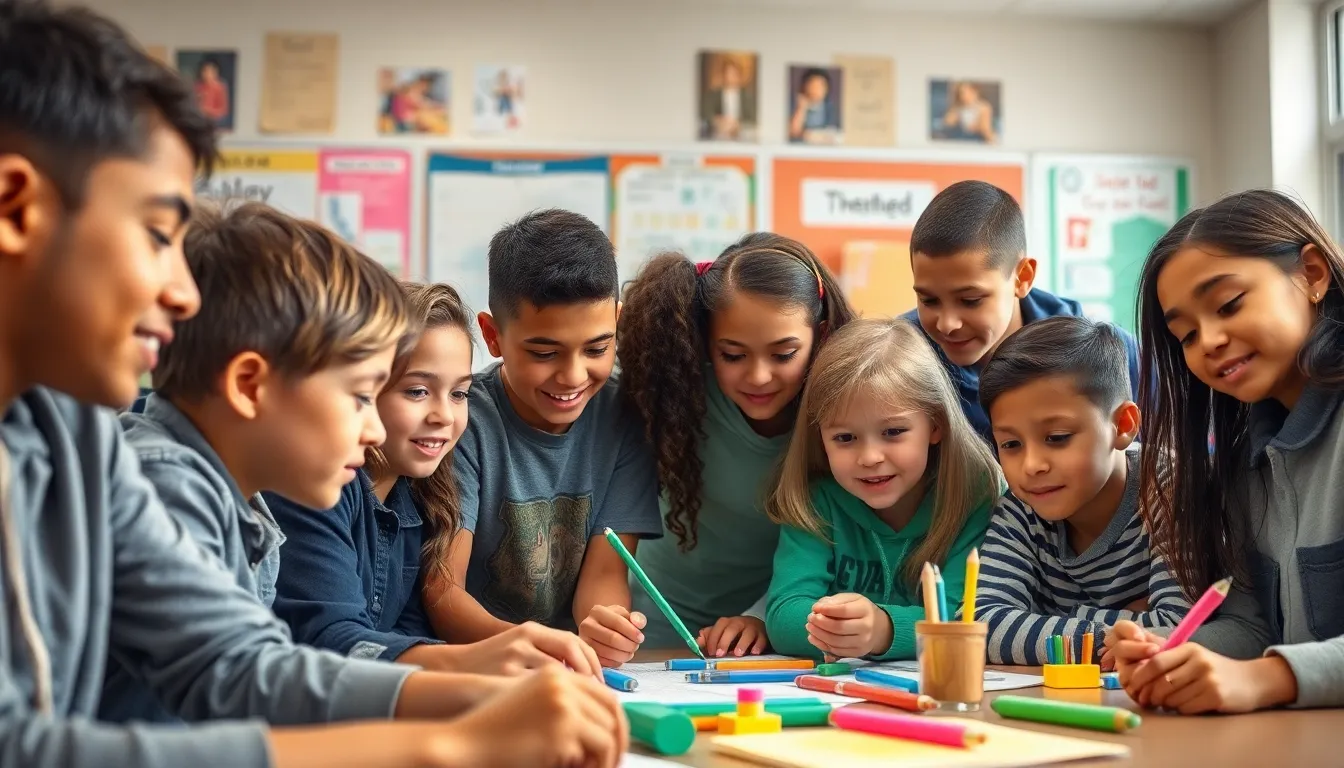In a world where everyone deserves a seat at the table, inclusive education strategies are the secret sauce to making it happen. Imagine a classroom where every student’s unique abilities shine brighter than a disco ball at a 70s party. It’s not just about fitting in; it’s about standing out together.
Table of Contents
ToggleOverview of Inclusive Education Strategies
Inclusive education strategies encompass various methods designed to meet the diverse needs of all students. These strategies promote accessibility and engagement within the classroom, ensuring every student can participate actively.
Differentiated instruction plays a crucial role in inclusive education. This approach involves tailoring teaching methods to address individual learning styles, allowing students to grasp concepts effectively. Educators often use various instructional strategies, such as visual aids, hands-on activities, and technology integration, to implement differentiation.
Universal design for learning (UDL) emphasizes creating flexible learning environments. UDL principles advocate for multiple means of representation, action, and engagement, catering to diverse learners’ needs. When materials are widely accessible, students engage more deeply with the curriculum.
Collaboration among educators is vital in developing an inclusive environment. Co-teaching models allow general and special education teachers to work together, enhancing support for students with varying needs. Teaming facilitates sharing expertise and resources, providing a richer learning experience.
Positive behavior interventions and supports (PBIS) foster a supportive classroom culture. PBIS aims to improve student behavior and promote emotional well-being. Consistent expectations and reinforcement help create a safe space where students feel valued.
Finally, fostering family and community engagement strengthens inclusive strategies. Open communication between teachers and families enhances shared understanding of students’ needs. Involving community resources further enriches educational opportunities, ensuring students receive comprehensive support.
Implementing these inclusive education strategies cultivates a more equitable and diverse classroom environment, where every student has the opportunity to thrive.
Benefits of Inclusive Education
Inclusive education offers numerous advantages that enhance the learning experience for all students. These benefits contribute to a more equitable and engaging classroom environment.
Enhancing Student Engagement
Engagement increases when inclusive practices are employed. Structured learning experiences allow students to participate actively, leading to improved motivation. Diverse teaching strategies, such as hands-on activities, encourage active involvement. Collaboration among students further enhances peer learning and communication skills. Research indicates that inclusive classrooms foster better academic performance, especially for students with disabilities. Tailored instruction targets individual needs, ensuring that every student remains involved and challenged.
Promoting Diversity and Empathy
Diversity within the classroom creates an atmosphere of understanding and acceptance. Exposure to various perspectives encourages students to appreciate differences. Empathy develops as students collaborate on group projects, fostering social skills and compassion. Classmates learn to support one another and value each individual’s contributions. This dynamic enhances community relationships and cultivates respect. Evidence shows that inclusive education promotes a sense of belonging, ultimately resulting in a positive school culture that benefits everyone.
Key Strategies for Implementation
Implementing inclusive education strategies involves a variety of methods that enhance the learning environment for every student. Two essential approaches include differentiated instruction and collaborative learning techniques.
Differentiated Instruction
Differentiated instruction tailors teaching practices to address individual learning preferences. Teachers assess students’ strengths and challenges, allowing them to customize lessons based on diverse abilities. By using varied instructional methods, such as visual aids, hands-on activities, and group discussions, educators cater to different learning styles. This approach promotes deeper comprehension and retention of material. Teachers also provide varied assessments to ensure that each student’s understanding is measured fairly. With all students engaged, learning becomes more accessible and interactive.
Collaborative Learning Techniques
Collaborative learning techniques foster teamwork among students, encouraging them to work together on assignments and projects. Small groups allow students to share diverse perspectives, enhancing problem-solving skills and promoting critical thinking. Teachers facilitate by creating an inclusive atmosphere where everyone feels valued. This strategy benefits all students, particularly those with different learning needs, as they learn from their peers. Regular reflection sessions help students evaluate their teamwork, enhancing social skills and self-awareness. Moreover, collaboration nurtures a sense of community, making the classroom a supportive environment for learning.
Challenges and Solutions
Inclusive education strategies can face several challenges in their implementation. These challenges often hinder the effectiveness and reach of inclusive practices in classrooms.
Common Barriers to Implementation
Lack of training for educators often limits their ability to effectively implement inclusive strategies. Resource availability presents another challenge, as many schools struggle with insufficient materials or support staff. Resistance to change from stakeholders can create barriers, as some may prefer traditional teaching methods. Time constraints impact the ability to plan and execute individualized learning experiences. Additionally, insufficient collaboration among educators often leads to fragmented support for students.
Strategies to Overcome Challenges
Professional development programs enhance educators’ skills in inclusive practices. Schools can allocate resources effectively by investing in specialized materials and support roles. Encouraging open communication among stakeholders fosters an environment receptive to change. Time management strategies help educators balance curriculum requirements with inclusive practices. Collaborative planning sessions allow teachers to share insights and strategies, creating a unified approach to support every student’s needs.
Role of Educators in Inclusive Education
Educators play a crucial role in fostering an inclusive education environment. They must adopt various teaching strategies that accommodate the diverse learning needs present in every classroom. Differentiated instruction allows educators to cater to individual learning preferences, enhancing engagement and understanding among students.
Co-teaching models provide opportunities for collaboration between educators, promoting a seamless integration of instructional methods that benefit all learners. Positive behavior interventions and supports help create a classroom atmosphere conducive to learning, encouraging positive interactions among students.
Training in inclusive education practices is essential for educators. Professional development empowers teachers with the skills necessary to implement effective strategies, overcoming common challenges associated with inclusive learning. Continuous support from school administration can reinforce efforts to foster inclusivity, allowing educators to focus on student needs.
Data-driven decision-making also supports effective teaching in inclusive classrooms. Using assessments and feedback, educators can identify areas of improvement and adjust their approaches accordingly. Ensuring that families are actively involved enhances the support network for students, creating a more cohesive learning experience.
Building relationships with students is another important aspect. Educators should recognize the unique strengths of each student and celebrate their differences. By promoting empathy and understanding, teachers contribute to a positive classroom culture where everyone feels valued.
Creating a collaborative environment fosters teamwork and peer learning. Encouraging students to work together helps them appreciate diverse perspectives while nurturing essential social skills. This dynamic ultimately strengthens the classroom community, ensuring that every student has the necessary support to thrive.
Conclusion
Embracing inclusive education strategies is essential for fostering a rich learning environment where all students can excel. By implementing tailored approaches like differentiated instruction and collaborative learning, educators can address the diverse needs of their students effectively.
The positive impact of these strategies extends beyond academic performance; they nurture empathy and understanding among peers, creating a supportive classroom culture. As educators continue to develop their skills and adapt to challenges, the goal of an equitable and inclusive education for every student becomes increasingly attainable.
With commitment and collaboration, schools can cultivate an atmosphere where every learner feels valued and empowered to thrive.







